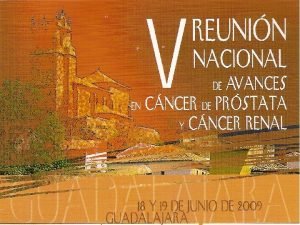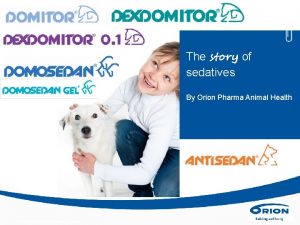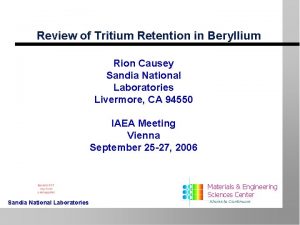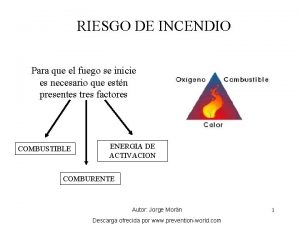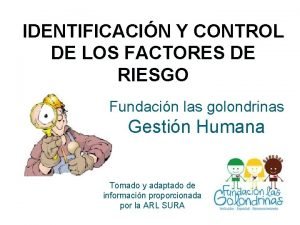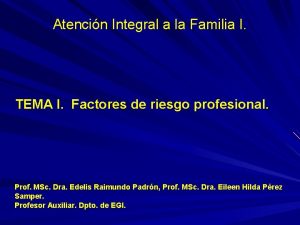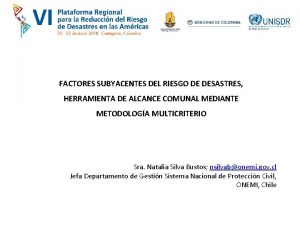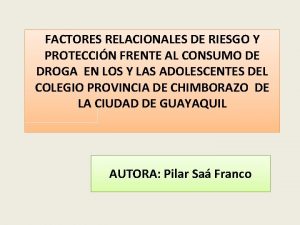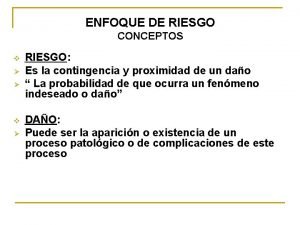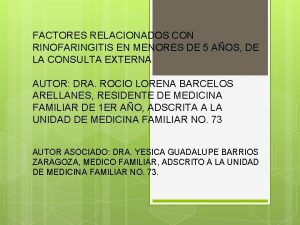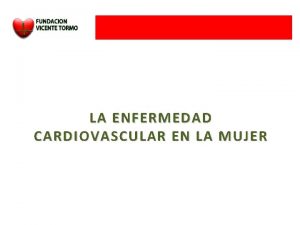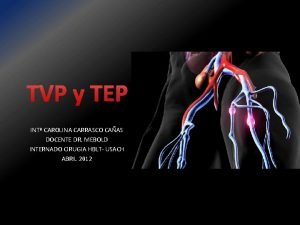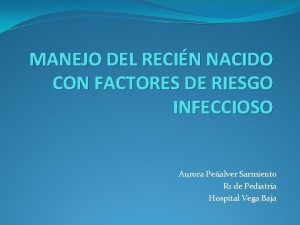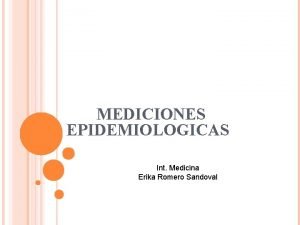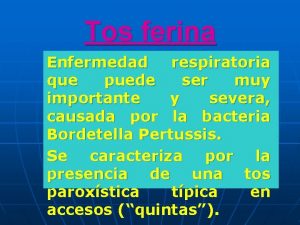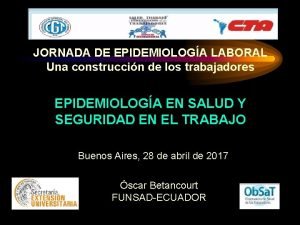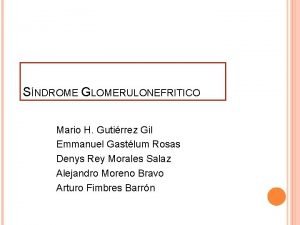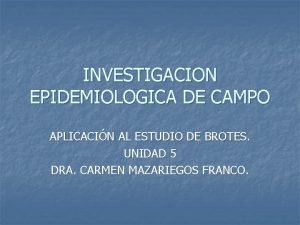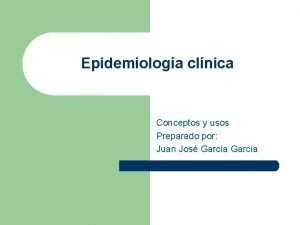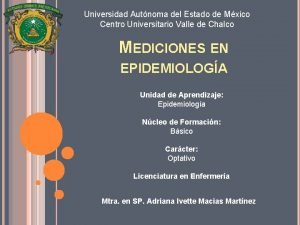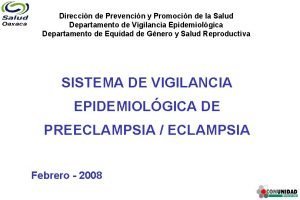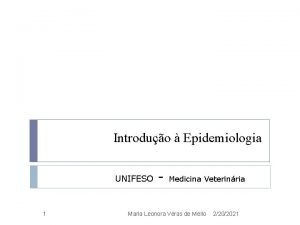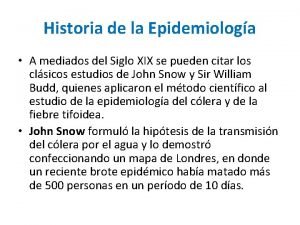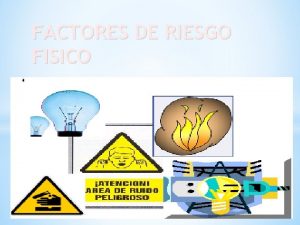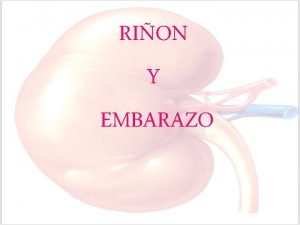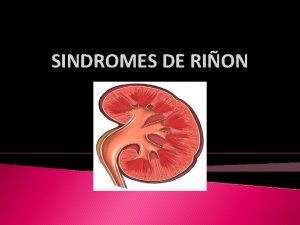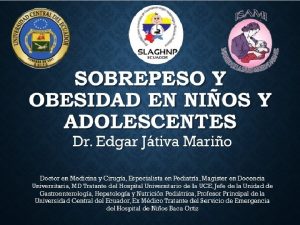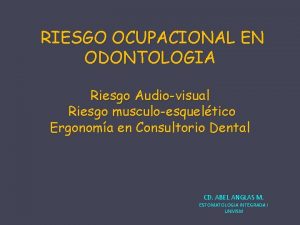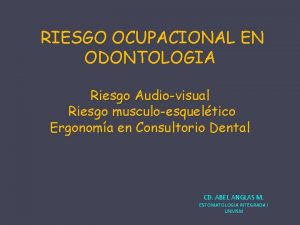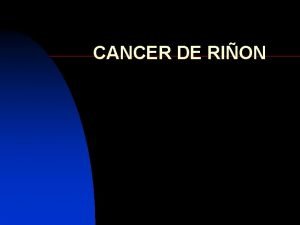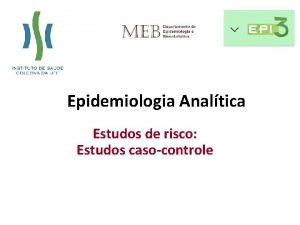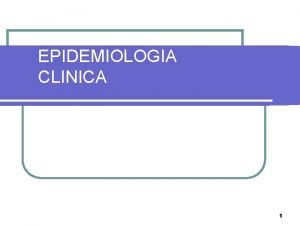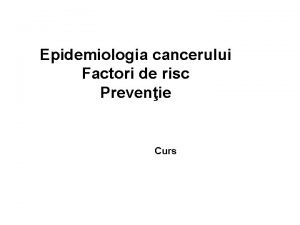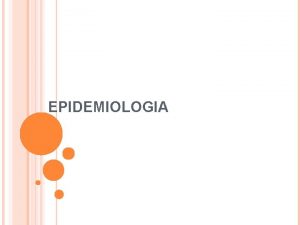EPIDEMIOLOGIA Y FACTORES DE RIESGO CANCER DE RION





























- Slides: 29


EPIDEMIOLOGIA Y FACTORES DE RIESGO CANCER DE RIÑON Prof. Dr. L. M. Antón Aparicio C. H. U. A Coruña

EPIDEMIOLOGY DEMOGRAPHIC ASPECTS • Incidence • Age / race • International incidence PROGNOSTIC FACTORS • Anatomic factors • Histologic factors • Clinical factors • Molecular markers RISK FACTORS • General • Gigarette smoking • Obesity / Dietary factors • Hypertension / Drug • Hormonal • Occupation • Transplantation / Dialysis PREDICTOR MODELS • Concept • Objective • Historical - perspective

DEMOGRAPHIC ASPECTS • • Accounts for 2% all new cares worldwide Twice as common men vs women Mean age at diagnosis early 60 s Incidence rates rising each year EU & USA ↑ incidental finding improved imaging technology ↑ incidence of late-stage has been observed ↓ autopsies • Incidence rates age/race adjunted white (m/w) black (m/w). 13. 8/6. 6 16. 8/8. 0 • International rate ↑ variability ↑ role for exogemous risk • Internacional incidence (Figure)

2002 RCC World Incidence and Mortality Rates, Stratified by Region World Regions Northern America Australia/New Zealand Western Europe Central and Eastern Europe Northern Europe Southern Europe Central America South America Western Asia Caribbean Southern Africa Eastern Asia Polynesia Southeastern Asia Northern Africa Micronesia East Africa Melanesia South Central Asia Middle Africa Western Africa Renal cancer incidence Renal cancer mortality 0 1 2 3 4 5 6 7 8 9 10 Rates per 100, 000 Ries LAG, et al. SEER Cancer Statistics Review, 1975 -2002.

RISK FACTORS (I) • GENERAL - Sporadic vs familial forms (two to fourfold) - Different types of genetic predispositions - Case – Control / Cohort studies (Table I & II) • CIGARETTE SMOKING - Meta-analysis (m vs w) smokers 1. 5 1. 2 relative risk 2. 0 1. 6 increased risk • OBESITY - ↑ 1. 07 per unit /body mass relative risk - Mechanism unknown - Hormonal change steroid hormonal IGF-I - Lipid peroxidation DNA adducts • HYPERTENSION - Hypertension ranging 1. 3 to 2 relative risk - Mechanism unknown - renal injury

RISK FACTORS (II) • ANALGESIC / DIURETICS / ANTI-HYPERTENSIVES - Phenacetin containing drug ? ? - ASS derivates ? ? - Hydrochlorothiazide / Furosemide ? ? • DIETARY FACTORS - Protein / alcohol consumption ¿? - Fruit / vegetable consumption protective effects • HORMONAL / REPRODUCTIVE FACTORS - Oral contraception ¿reduced risk? - Hysterectomy / ophorectomy in consistent - Menarche / menopause not affect risk • OCCUPATION - Jobs / industries asbestos ¡! petroleum works ¿? solvent trichloro ethylene ? ? • TRANSPLANTION / DIALISIS - Duration of dialysis increased risk - Mechanism of action acquired renal cystic disease

PROGNOSTIC FACTORS (I) • ANATOMIC FACTORS • Tumor size • Tumor extesion/ adrenal involvement • Venous involvement • Lymph node involvement • Metastasis • HISTOLOGIC FACTORS • Tumor grade (TNM) • Histologic morphology • Tumor necrosis • Microvascular invasion • Sarcomatoid features • CLINICAL FACTORS • Performance status • Laboratory abnormalitis • Paraneoplastic syndrome • Thrombocytosis • MOLECULAR MARKERS • Angiogenesis • Proliferation • Apoptosis • Others

PROGNOSTIC FACTORS • ANATOMIC FACTORS • Tumor size 5 -year cancer-specific survival (rate) T 1 T 2 T 3 Range 91% to 60% 74% to 71% 67% to 37% (T 1 a T 1 b) (T 2 a T 2 b) (T 3 a T 3 b) • Tumor extensión • Adrenal involvement 5 -year cancer-specific survival (rate) Similar to T 4 • Venous involvement 3 -year cancer-specific survival (rate) 70% 63% (below diaphragma) 23% (above diaphragma) RV IVC • Lymph node N+ 2 -year cancer-specific survival (rate) Range 10% to 20% (II)

PROGNOSTIC FACTORS (III) HISTOLOGIC FACTORS • Histologic morphology Main subtypes Clear cell 70%-80% 5 -year cancer-specific survival Papillary 10% 15% (type 2 more aggressive) Chromophobe 5% Collecting duct 1% (Medullary Ca. Poor prognosis) 68% 87. 4% 86. 9% • Tumor necrosis Incidence Clear cell 28% Papillary 47% Chromophobe 20% Independent predictor of survival (twice the risk of death) Indipendent predictor of poor out come (clear cell risk ratio 1. 95) • Microvascular invasion Indicence 25% to 28% Independent predictor of disease recurrence Independent predictor of cancer-specific survival • Sarcomatoid fratures Found in less than 5% High – grade forms of RCC Associated with a poor outcome

PROGNOSTIC FACTORS (IV) CLINICAL FACTOR • Performance status 5 -year cancer-specific survival ECOG-PS 0 81% ECOG-PS ≥ 1 51% Independend prognostic factor of survival in m. RCC Independent predictor of poor outcome • Paraneoplastic syndrome Cachexia – related findings: anorexia, malaise, weight loss Overall incidence 14 -8% Independent predictor of both poor prognosis and / or outcome Significantly affect recurrence free survival, cancer-specific survival • Laboratory abnomalities - Thrombocytosis / Anemia - Serum Calcium - Serum lactate dehydrogenase - Hypoalbuminemia

MOLECULAR MARKERS (I) MOLECULAR PROGNOSTIC FACTORS Hypoxia inducible CAIX CAXII CXCR 4 VEGF ILGF-1 Proliferation ki-67 Cell cycle regulation P 53 Bcl-2 PTEN Cyclin A P 27 Cell adhesion Ep. CAM EMA E-cadherin a-Catenin Cadherin-6 Miscellaneous Gelsolin Vimentin CA 125 CD 44 Androgen receptors Caveolin-1 VEGFR

MOLECULAR MARKERS (II) HIPOXIA INDUCIBLE FACTORS ↑ HIF-1α expression: an independent predictor of survival (Clear cell) ↓ CA Ix expression: an independent prognostic indicator poor survival (m RCC) an predictor with response to IL-2 VHL alterations: an independent predictor of cancer-free survival an independent predictor of disease-free survival VEGF-A / VEGF-2: higher expression (papillary) / lower expression (clear) VEGF-A, VEGFR-1, VEGFR-2: (↑ epithelium) independent predictor lymp node involvemt independent predictor disease-free survival VEGFR-3 (↓ low endothelial) independent predictor lymph node involvement independent predictor disease-free survival

MOLECULAR MARKERS (III) REGULATOR APOPTOSIS p 53 • Tumor-suppressor gene incidence range 16% to 57% ↑ papillary, metastatic overexpression: independent predictor poor survival independent prognostic disease progression (clear) indipendent predictor disease recurrence BCl-2 • Survival protein incidence range 10% to 80% Expression: significant correlation higher tumor grade correlated with improved overall survival associated with lower stage & grade not predict disease-free or disease-specific survival not correlated with recurrence & metastasis Smac/DIABLO • caspase family proteins incidence: lower + expression: inversely correlated with tumor grade - expression: worse cancer-specific survival

MOLECULAR MARKERS (III) REGULATOR CELL CYCLE p 27 ↓ expression PTEN • regulated proliferation G 1/s transition Cyclin-dependent kinases Higher-grade & large tumor size Independent predictor poor disease & specific survival • Tumor – suppressor protein PI 3 K – AKT – m. TOR signaling pathway + Expression: ↓ Expression: Loss expression: Found to correlate with p. AKT & HIF-1α expression Independent predictor poor survival (m clear RCC) Increased in all RCC ↓ loss: Clear cell RCC & sarcomatoid features p. AKT: SGK: Collecting duct (89%) Sarcomatoid (61%) High-grade 73% High-stage 50% ADHESION MOLECULES Ep. CAM Eph A 2 Frequently absent (clear cell RCC) Independent predictor improved disease- specific survival Associated larger tumor size Predictor decrease-free recurrence & overall survival Clear cell (58%) Clear cell (41%) 31% 30%

P 53 is an independent predictor of tumor recurrence and progression after nephrectomy in patients with localized renal cell carcinoma RR: 14. 4% § 193 localized RCC §TMA: CA 9, CA 12, gelsolin, p 53 Ep. CAM and p. TEN § 15% tumor recurrence RR: 37. 7% §Univariate analysis: T stage, grade, ECOG, Ki 67, Ep. CAM and p 53 were significantly associated with recurrence (p<0. 05) §Multivariate analysis: T stage, ECOG, and p 53 were the 3 most significant predictors of tumor recurrence Shvarts, O, Seligson D, Lam J et al. J Urol; 2005: 725 -728

Using protein expression to predict survival in RCC q 318 RCC patients q. TMA: Ki 67, p 53, gelsolin, CA 9, CA 12, PTEN, Ep. CAM and vimentin CA 9 PTEN CA 12 Ep. CAM WORSE SURVIVAL Ki-67 P 53 Vimentin gelsolin Kim, H. L. et al. Clin Cancer Res 2004; 10: 5464 -5471

A prognostic model based on a combination of clinical and molecular predictors Multivariate analysis: p 53, CA 9, vimentin were statistically significant predictors of survival independent of the clinical variables metastasis status, T stage, ECOG and grade. Prognostic systems based on protein expression profiles for clear cell RCC performed better than standard clinical predictors Kim, H. L. et al. Clin Cancer Res 2004; 10: 5464 -5471

INTEGRATED PREDICTION MODELS Concept: Integration of independent prognostic indicators into comprehensive out come models Objetive: To facilitate patient counseling To identify patients who might benefit from therapy Historical perspective 1986 1988 2001 UISS 2001 2002 SSIGN 2002 MSKCC 2004 2005 Maldazys JD Elson PJ Kattan MW Zisman A Frank I Motzer RJ Mekhail TM J Urol Cancer Res J Urol J Clin Oncol 136: 376 -379 48: 7310 -7313 166: 63 -67 10: 1649 -1657(UCLA) 20: 4559 -4560 168: 2395 -2400(Mayo Clinic) 22: 454 -463(Memorial) 23: 832 -841(Cleveland Clinic) Types Preoperative models: Yayciogly and Cindolo Postoperative models: Kattan momogram

Risk Groups for Advanced RCC Risk Groups No. of Risk Factors 2 -Year Survival Rate, % Favorable Risk 0 45 Intermediate Risk 1 -2 17 High Risk ≥ 3 3 q Pretreatment features associated with shorter survival Low Karnofsky performance status (< 80%) High lactate dehydrogenase level (> 1. 5 x normal) Low hemoglobin level High serum calcium Absence of nephrectomy Motzer RJ, et al. J Clin Oncol. 1999; 17: 2530 -2540.

Survival stratified according to risk group MS: 20 m MS: 4 m MS: 10 m Motzer, R. J. et al. J Clin Oncol; 17: 2530 1999

Fig 3. Kaplan-Meier survival analysis of the study population according to the UISS categories Zisman, A. et al. J Clin Oncol; 19: 1649 -1657 2001

Comprehensive staging systems for localized and metastatic RCC Kattan (localized) Frank (SSIGN) Zisman All (localized) (localized and metastatic) (UISS) Tumor subtypes All Clear cell Prognostic indicators TNM, size, histology, symptons TNM, size, grade, TNM, grade, necrosis ECOG Prognostic information recurrence survival

Comparison of Predictive Accuracy of Four Prognostic Models for Nonmetastatic Renal Cell Carcinoma after Nephrectomy 2404 patients Kattan and UISS postoperative models Cindolo and Yaycioglu preoperative models KATTAN MODEL WAS THE MOST ACCURATE IN PREDICTING PROGNOSIS Cindolo L, Patard JJ, Chiodini et al. Cancer 2005; 1362 -1371

Factores pronóstico desfavorables dependientes del paciente de uso común Presentación con síntomas de enfermedad Pérdida de peso (>10% de masa corporal) ECOG 2 -3 Reactantes de fase aguda o VSG > 30 o Proteína C Reactiva elevada Anemia o Hb< 10 g/dl en mujer o Hb< 12 g/dl en varón Hipercalcemia Fosfatasa alcalina elevada Hipoalbuminemia Trombocitosis

Factores pronóstico desfavorables dependientes del paciente no consolidados • • • Edad Sexo Raza Localización geográfica Nivel socioeconómico

Factores pronóstico desfavorables dependientes del tumor de uso común q Macroscópicos § Afectación de márgenes quirúrgicos q Metástasis § § § Presencia de múltiples metástasis Afectación hepática o pulmonar Presencia de trombo en sistema venoso q Microscópicos § § § TNM (factor pronóstico más importante descrito) Grado nuclear necrosis q Tipo histológico § § § Células claras convencional Carcinoma de conductos colectores Sarcomatoide q Morfología nuclear: área aumentada y formas variables q Contenido en DNA: aneuploidía q Marcadores de proliferación § § Ki-67 elevada Ag-NOR (proteínas nucleolares argirófilas) elevado

Factores pronóstico desfavorables dependientes del tumor no consolidados • • • Fase S elevada PCNA elevado P-53, bcl 2, p 21 Factores de crecimiento Moléculas de adhesión celular Angiogénesis

CONCLUSION The last decade has lead to the gradual transition from the use of solitary clinical factors as prognostic markers to the introduction of systems that integrate molecular and genetic markers. These markers will eventually enhance our ability to predict individual tumor behavior and stratify patients into more sophisticated risk categories. They also can select patients for targeted biological therapies and transform the management of this malignancy in the near future.
 Factor de transferencia cancer
Factor de transferencia cancer Factores de riesgo factores protectores
Factores de riesgo factores protectores Orion pharma animal health
Orion pharma animal health Rion causey
Rion causey Factores de riesgo de incendio
Factores de riesgo de incendio Factores de riesgo en la salud
Factores de riesgo en la salud Factores protectores ejemplos
Factores protectores ejemplos Factores de riesgo psicosocial en la familia
Factores de riesgo psicosocial en la familia Factores subyacentes del riesgo
Factores subyacentes del riesgo Riesgo fisico
Riesgo fisico Riesgos internos y externos ejemplos
Riesgos internos y externos ejemplos Riesgo locativo consecuencias
Riesgo locativo consecuencias Riesgos relacionales
Riesgos relacionales Cuales son los factores de riesgo
Cuales son los factores de riesgo Factores de riesgo de la rinofaringitis
Factores de riesgo de la rinofaringitis Factores de riesgo modificables
Factores de riesgo modificables Dimero d elevado
Dimero d elevado Recin
Recin Riesgos individuales
Riesgos individuales Romero sandoval erika andrea
Romero sandoval erika andrea Difteria
Difteria Epidemiologia laboral
Epidemiologia laboral Epidemiologia
Epidemiologia Investigación epidemiológica de campo
Investigación epidemiológica de campo Epidemiologia clinica
Epidemiologia clinica Prevalencia
Prevalencia Norma 017 epidemiologia
Norma 017 epidemiologia Epidemiologia
Epidemiologia Epidemiologia
Epidemiologia Epidemiologia experimental
Epidemiologia experimental
